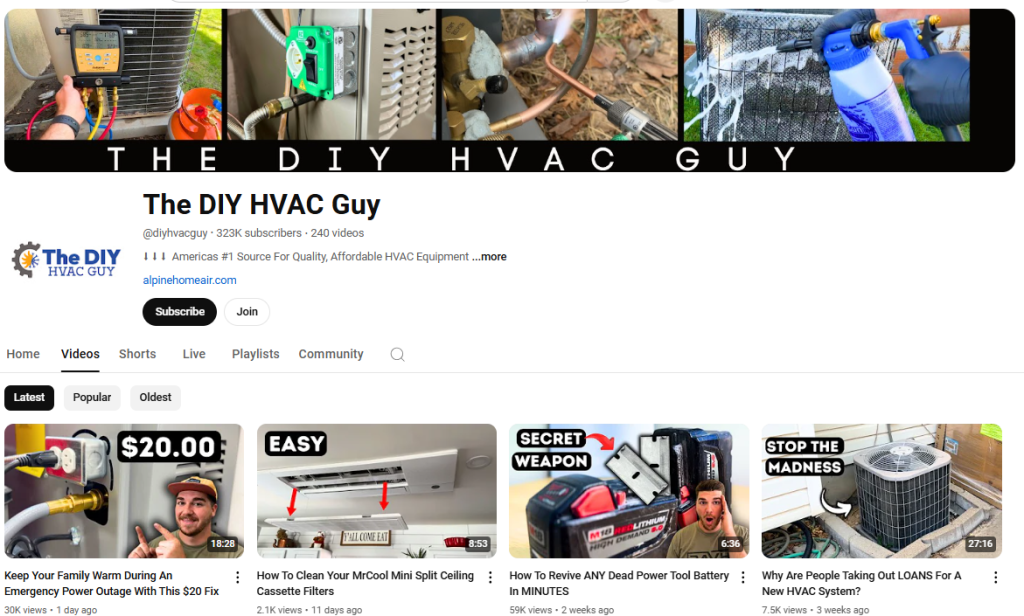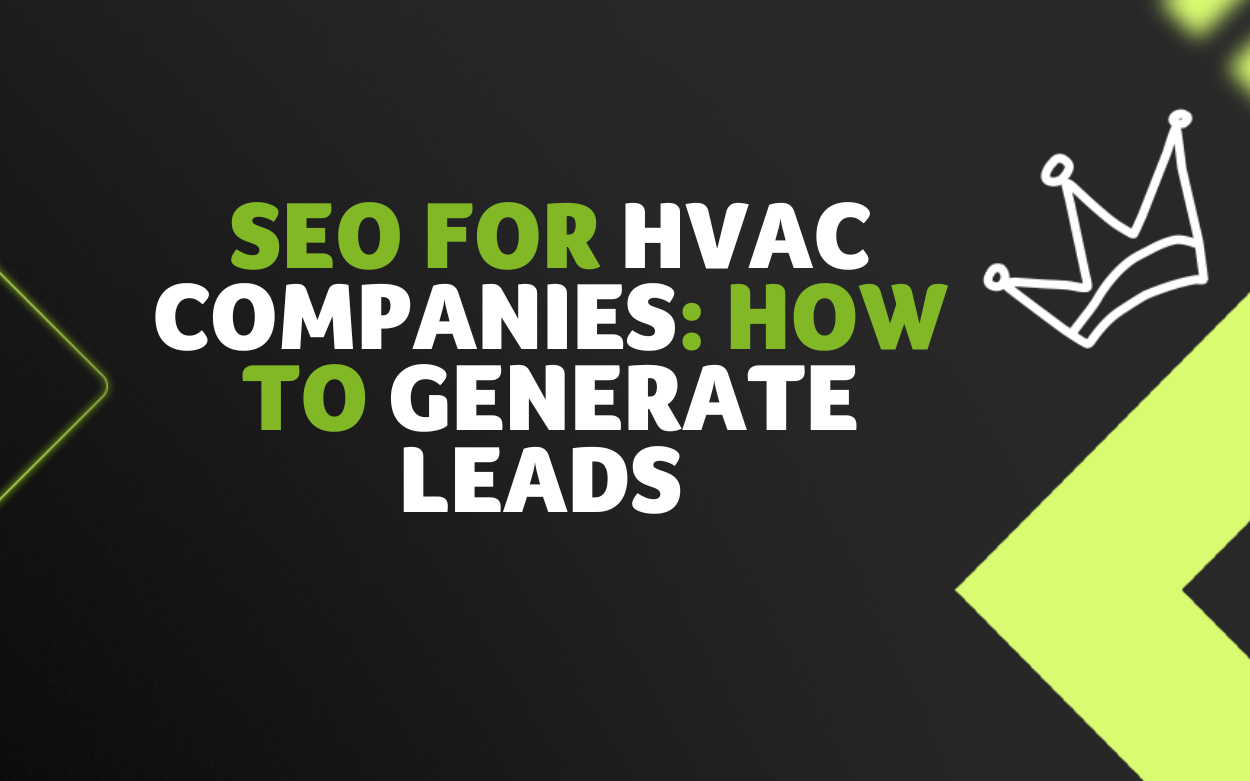
Did you know that 60% of HVAC contractors say that content optimized for search engines is their best source of leads?
If you’re not investing in HVAC search engine optimization (SEO), then you risk losing business to competitors.
However, HVAC SEO can be time-consuming and difficult to understand, so it’s important to know which actions can provide the best results with the least effort.
This article explains the basics of SEO for HVAC companies, helping you maximize the new business opportunities you get from your website.
What is SEO for HVAC Companies?
HVAC SEO is the process and techniques used to help HVAC companies rank higher on search engines.
Search engines use algorithms to determine what ranks at the top of search results. These algorithms judge websites based on a whole range of factors, such as:
🔍 How relevant a website is to the user’s search.
🔍 How well-regarded the website or company is in its industry.
🔍 The quality of the website’s content.
🔍 Whether audiences engage with the website.
🔍 How often the website is updated.
🔍 The website’s user experience.
Optimizing your website to meet these factors helps search engines understand your content, making it more likely it’ll be shown in relevant searches.
Why is SEO Important for HVAC Contractors?
When someone needs a service, what’s the first thing they do? Most often, they search online.
The HVAC industry is no different. A quick look on SEO tool Ahrefs shows that the term “HVAC near me” gets around 48,000 searches per month—that’s 576,000 per year!

In other words, more than half a million people use Google every year to find air conditioning and heating services like yours.
And most of these people will click on the top three results. According to FirstPageSage, the first Google result gets nearly 40% of all clicks. Second place gets 18.7%, third gets 10.2%.
Page two gets almost none.
If you were to rank page one for the term “HVAC near me,” you’d likely get around 230,000 visitors to your website each year.
Let’s say 2% of those customers convert and buy your services. That’s 4,600 customers.
The average U.S. homeowner spends around $1,000 per year on heating and cooling.
That’s potential earnings of $4,600,000. The average annual cost of SEO ranges from $30,000–$120,000. That’s a 38x return on investment!
HVAC SEO is also great for:
✔️ Improving online visibility
✔️ Improving brand awareness
✔️ Improving your website’s user experience
✔️ Engaging with your customers and industry
The following section provides a step-by-step guide to optimizing your website to rank higher and generate more organic traffic.
Step-by-step HVAC SEO Marketing Strategy
Any efforts you make regarding your HVAC SEO will boost your advantage over competitors. However, some things are more fundamental than others in the HVAC industry.
Follow the steps below one at a time to ensure you do the most critical tasks first.
1.Set up local citations
Most people use local companies when choosing HVAC companies. This means most people use local SEO search operators when using Google to find services.
Examples include:
🔍 HVAC engineer near me.
🔍 HVAC repairs [my city].
Local citations are anywhere online where you mention your business’s name, address, and phone number (NAP). The most common examples are business directories.
Citations are important for SEO, showing search engines that you are a real HVAC business that is actively advertising its services. They also prove you are based in a certain location.
This means they will be more likely to show your website when people in your area search for HVAC services.
The most important local SEO citation is a Google Business Profile. Here’s how you can set one up.
Google Business Profile
Google treats local searches differently from standard ones. Google uses your business’s proximity to the searcher, along with review data, to decide what to show you.
It also shows the information differently, presenting a list of local search results with a map showing the location of each.
The standard list of results is then shown below. Sometimes, it will show you directories and social media channels where you can find businesses at the top of the page.

Needless to say, appearing in these results is critical if you want to generate leads from local businesses and homeowners—but that won’t happen unless you set up a Google Business Profile. Here’s how:
- Sign in to Google: Use your HVAC business email account to register. Go to the Google Business Profile page and click “Manage Now.”

2. Add your HVAC business information:
💡 Enter your business name and choose an industry-appropriate category.
💡 Add a precise address if you have a physical location.
💡 Add contact details, including your phone number and website URL.
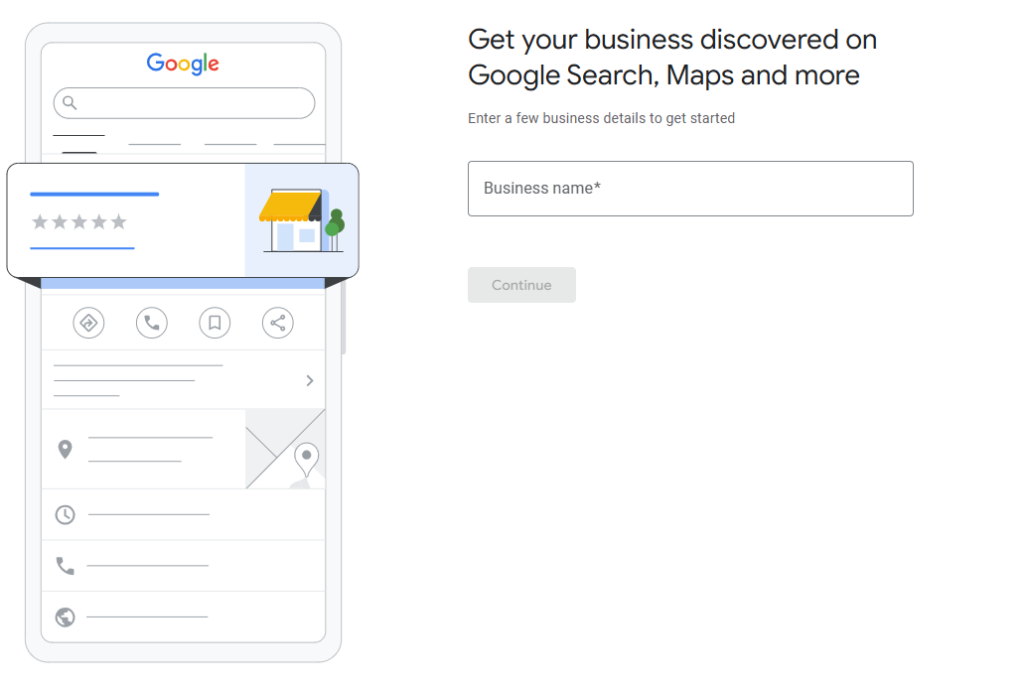
3. Google typically sends a postcard with a code to verify physical locations, but other options may be available based on your settings.
4. Optimize your profile:
💡 Add high-quality photos: Include your HVAC business logo, team photos, and product images.
💡 Add business hours: Keep them accurate to reflect when customers can reach you.
💡 Enable messaging: Use the messaging feature so customers can directly communicate with you through Google.
💡 Manage reviews: Encourage satisfied customers to leave reviews and respond to all reviews professionally to build trust.

Set up local directories
Google Business Profile isn’t the only local citation. You should also get yourself set up on other relevant directories.
This should include general ones like Yelp and Yellow Pages, as well as specialized industry directories like the one below.
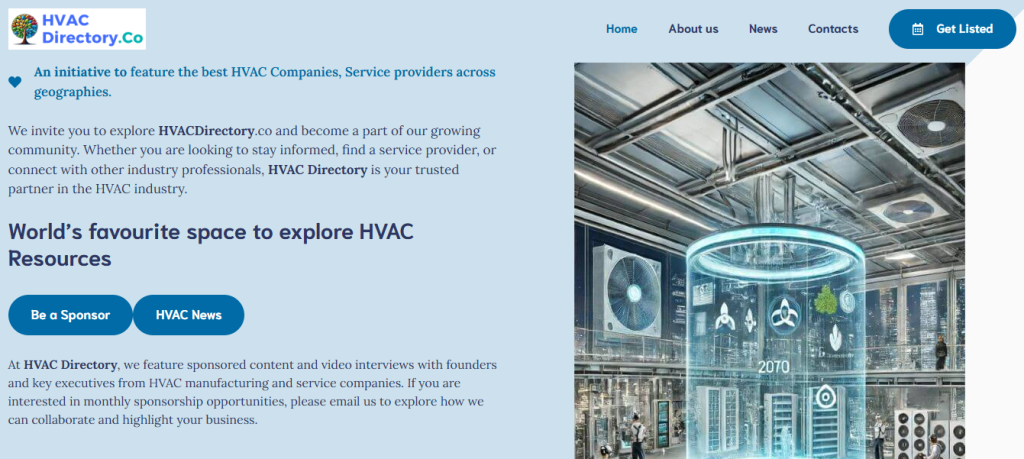
Finally, it’s also a good idea to sign up for location-based directories like this one.

This combination of industry and local directories will help show search engines where your HVAC business is based and what sector it operates in.
2. Set up Social media
Social media is great for engaging with your audience. However, it also shows search engines that your brand is active online beyond its website, positively impacting your HVAC SEO.
Choose to focus on one or two social media platforms that best reflect your customer base. We recommend Facebook and Instagram, as these are popular with older age groups who are more likely to be homeowners.
Here are some tips for your social media strategy:
💡 Provide useful content: Post about issues your customers might be facing and the solutions they can implement.
💡 “Job done” posts: Post pictures of recently completed projects to show the quality of your workmanship and breadth of expertise. This is also a chance to introduce followers to satisfied customers.
💡 HVAC business posts: The quality of your work will be reflected in its success. Post whenever you do things like take on new staff, win awards or get new premises.
💡 Use hashtags: Hashtags allow social media users to see posts about a certain topic. This helps you connect with audiences with shared interests. Some good examples of relevant hashtags include:
- #hvac
- #hvaclife
- #airconditioning
- #hvactech
- #hvactechnician
- #hvacr
- #heating
- #hvacservice
- #hvactools
- #hvacrepair
- #hvaclove
- #hvachacks
- #hvaccontractor
- #refrigeration
- #hvacinstall
- #furnace
- #ac
- #cooling
- #hvacproblems
- #heatingandcooling
3. Find HVAC keywords
Keywords are the terms people type into search engines to find what they need. Using relevant keywords on your website helps you rank for these terms. It also helps Google understand what your website is about.
Relevance isn’t the only important factor in keyword research. You should also look for terms that are:
🔍 High volume: The keyword gets enough monthly traffic to make it worth targeting.
🔍 Low difficulty: Keywords that are more likely to result in a sale, or result in a higher value sale, are more competitive than those that don’t. The term used to measure this is called “keyword difficulty”. SEO tools like Ahrefs measure it on a scale of 1-100, the higher the keyword difficulty the harder it is to rank for a term.
🔍 Who else ranks for a term: It’s harder to rank for a term if lots of well-known, well-regarded websites in your industry rank for them too. For example, if a global brand like Mitsubishi ranks for a term, then it will be difficult to rank higher than it.
Earlier in this article we provided a screenshot from the SEO tool Ahrefs. This showed an overview providing all this information.
Scroll down and you’ll see data on the other websites that rank for the term, so you know what you are up against.
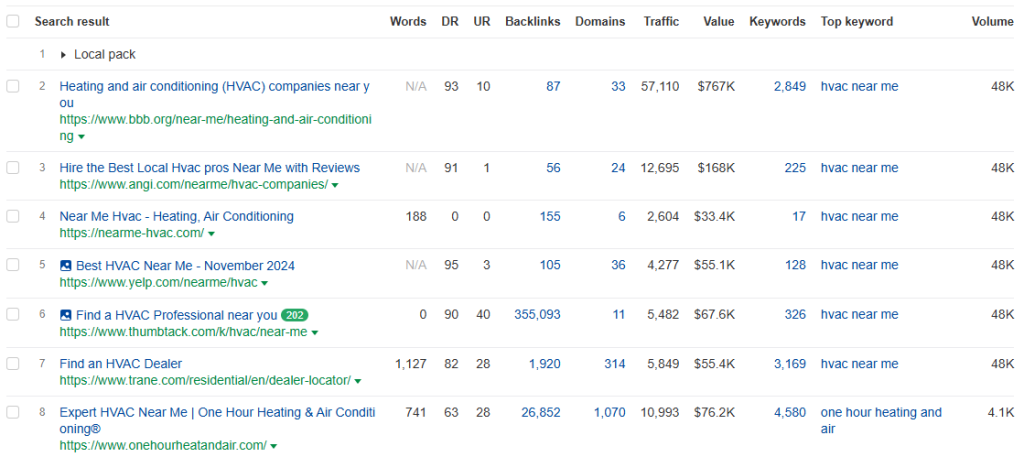
But how do you come up with keywords in the first place? Let’s take a look at that in detail.
How to carry out keyword research
Here’s how to find the right keywords step-by-step:
1. Think about your strategy
Different types of keywords reflect different user needs and, therefore, the kind of content you create to meet them.
🔑 Commercial keywords: These are those that reflect users ready to buy a service. This could include “HVAC engineer near me” or “emergency heating repairs [city]”.
🔑 Informational keywords: Target users researching an issue. They don’t need services now, but they might in the future. If you can answer their question now, then it’s more likely they will think of your business when it’s time to make a purchase.
🔑 Navigational keywords: Sometimes known as branded keywords, these are when a user is seeking a specific company. This is only relevant if your brand is well known.
2. Come up with keyword ideas
There are two main approaches to keyword research:
#1 Brainstorm ideas: Think about what matters to your customers, the kinds of questions they commonly ask you, and the services you offer that are popular. Think about keywords that reflect these needs.
#2 Use an SEO tool: Ahrefs has a special tool called competitive analysis. This allows you to compare websites for different factors, including what keywords they target.
Type your domain address into the top bar and then type the websites you want to compare it to beneath.

Click “Show keyword opportunities,” and you’ll see a list of keywords that your competitors rank for, but you don’t. These can be added to your keyword shortlist.
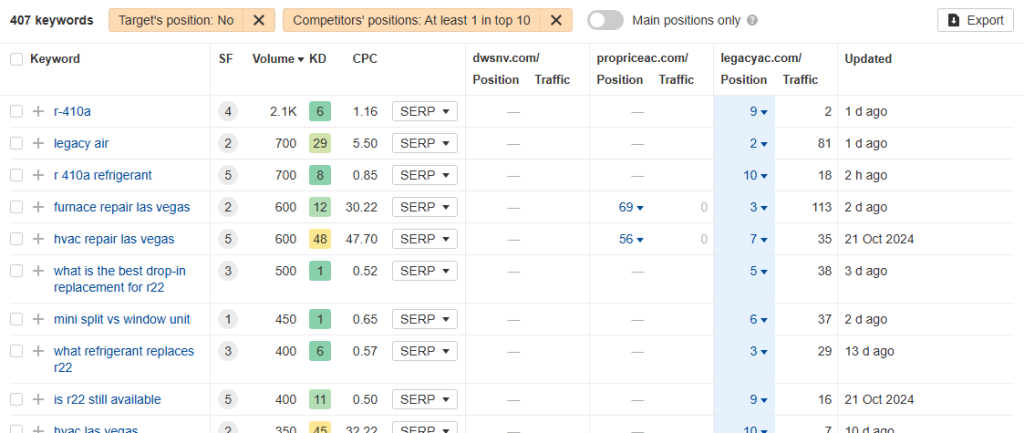
3. Find long-tail keywords
Basic keywords like “HVAC” are known as seed keywords. Because they are so broad, they tend to attract a lot of traffic and are typically hard to rank for—as shown in the image below.

Long tail keywords, as the name suggests, are longer and more descriptive key terms. For example, HVAC might become “ac repair cincinnati”.
This gives you more information about what the user needs and where they are based. Because the term is more detailed, it attracts less traffic and is therefore easier to rank for.

We recommend targeting long-tail keywords to begin with, as this will likely generate results faster than targeting seed keywords.
You can find them by looking below the overview page for one of your seed keywords on Ahrefs. Here, you’ll find four lists of keyword ideas:
- Terms match: Terms that include the target keyword.
- Questions: Queries including the search term that are phrased as questions.
- Also rank for: Keywords that the top 10 ranking articles also rank for.
- Also talk about: Keywords and phrases also mentioned in the top 100 articles.

4. Prioritize keywords
Add your keywords to a spreadsheet as you go, noting their search volume and keyword difficulty.
Once you have at least 100 keywords, identify the ones with the best balance of being easy to rank for and that have the most traffic.
You can create keyword lists in Ahrefs using the “Add to” button in the top right. These lists can be exported to a spreadsheet at the touch of a button once finished.

4. Create quality content
Regularly posting quality content that is useful to potential customers is critical for SEO. That’s because:
- It helps you rank for relevant keywords.
- It keeps your website up-to-date.
- It indexes your website quicker.
- It shows Google (and users) that you are an expert in your field.
What’s indexing?Not every web page can be found on Google; only ones that are included in its index. This is a bit like a directory of the websites it knows about. Indexing is when Google adds new website content to its index. It does this by following hyperlinks between pages and websites to discover new content. The more it finds new content on your website, the more likely it is to visit it regularly. |
Example: New refrigerant guide
Here’s an example of content by Nevada-based Sierra Air Conditioning and Plumbing. The company has created a guide explaining a regulatory requirement to phase out common refrigerants from air conditioning units to homeowners.
It answers their questions, explaining how the new regulations will impact them and what action they should take.

This works well because it:
✔️Is useful for Sierra’s customer base.
✔️Provides genuinely useful information on a complex topic.
✔️Shows off the company’s expertise.
✔️Encourages readers to contact Sierra if they need more information or assistance with their air conditioning system.
5. On-page SEO
On-page SEO involves optimizing the elements within web pages. Content is a large part of on-page SEO, but it’s so important that we gave it its own section.
Other elements of on-page SEO include:
Title tags
These are the clickable headlines on search engine results pages (SERPs) showing the title of the web pages. You can optimize title tags by including primary keywords, keeping them under 60 characters, and making them descriptive and engaging to attract clicks.

Meta descriptions
This brief summary of the page appears below the title tag on SERPs. Meta descriptions should be 160 characters and include the target keyword. They should accurately summarize the content, and entice users to click.

Headers (H1, H2, H3)
Headings structure content and make it easier for readers and search engines to understand the page hierarchy. Use H1 for the main title and H2s/H3s for subtopics. Include keywords in subheadings, but keep them natural and relevant to the content.

URL Structure
The URL is a webpage’s address that you type into the top bar of a browser. It consists of:
- Your domain name, e.g., https://hvacsandiego.com
- The subdirectory, e.g., https://hvacsandiego.com/ac-services
Your URL structure helps search engines and users understand the page content. Use clean, readable URLs that include target keywords. Break words up with dashes, but avoid long subdirectory names, symbols, or numbers.
Internal Linking
These are hyperlinks within your content that direct users to other pages on the same site. They support navigation and help search engines index your site. They also share the authority backlinks generated across your site—more on this in the net section. Add links to relevant pages wherever you think it is useful for readers.
6. Build backlinks
Sometimes known as off-page SEO, backlinks are when other domains post a hyperlink to your website.
Backlinks are a huge ranking factor. Why? Because people usually post a backlink because they think the content is useful for their audience.
Most businesses will naturally attract backlinks. For example, satisfied customers will post links to tell people about your business, or your expert HVAC content might be referenced by content creators.
However, proactively building backlinks can boost rankings and give you a competitive advantage.
It’s important to understand that not all backlinks are equal. Some will have a bigger impact on your rankings than others.
What makes a bad backlink?
Before explaining what makes a good backlink, it’s worth explaining what makes a bad one.
Most business owners know that backlinks have a powerful impact on their rankings. But what they don’t realize is that Google and other search engines set best practice guidelines for them.
This is because unscrupulous link builders were taking their clients’ money and building tons of spammy links that offered no value to readers.
If you build too many poor-quality backlinks, Google might ignore them or even worse, penalize you—meaning your rankings might go down!
Spammy link building techniques often include:
- Irrelevant or low-quality comments or forum posts.
- Posting on sites that only exist to make money from backlinks.
- Using automation to build links en-mass
- Cloaking – in other words, showing one version of your website to search engines and another to users.
It’s critical to build high-quality backlinks—so let’s find out what they are.
What makes a good backlink?
Good backlinks are:
Relevant: This is the most important factor. Backlinks from websites in or associated with your industry have a greater impact on rankings than those that are not. For example, a link from an HVAC trade association will be more valuable than a backlink from a gardening website.
Natural: As mentioned above, Google and other search engines don’t like high-volume, spammy link building techniques. Instead, they like to see a variety of different link sources, and anchor text formulations, that appear gradually. Imagine if an HVAC company suddenly got 100 backlinks overnight all from guest posts—does that sound natural or like someone has built a tonne of spammy links?
From high-quality websites: Try to get backlinks from websites with well-written, comprehensive content that gets lots of traffic and backlinks itself. This will have a greater impact on your rankings than links from websites with poor-quality content.
Location: Backlinks from websites based in the same region as you are more valuable than those further afield. Think about it, if you provide HVAC services in Tucson, then a mention in the local press is probably more relevant than a link from a website in India.
High authority websites: Website authority is a measure of how well-regarded a site is by others in its industry. This is usually measured on a scale of 0-100. Different SEO tools have different measures of this. The most common are:
- Domain Authority (DA): Developed by Moz.
- Domain Rating (DR): Developed by Ahrefs.
Both essentially measure the same thing but are calculated slightly differently. The main consideration for each is the number of backlinks and referring domains pointing to the site.
You should aim to build as many high-authority backlinks as possible.
| What should I do if I have links from websites with poor content or authority?
Poor quality content and low authority aren’t necessarily indicators of spammy links. It’s natural for websites to attract links from a range of different websites, so links from lower-quality websites will show search engines that you are naturally generating backlinks. However, too many backlinks from websites that engage in spammy SEO practices could lead to a penalty. If you think you have too many spammy links or have suffered a Google penalty, then check out our article on disavowing backlinks to find out what to do. |
How do you build links? Let’s explore some of the strategies.
3 Link building strategies for HVAC businesses
We’ve already mentioned high-quality content—this is the foundation of good link building.
If you provide content that is useful or interesting to people in your industry, then you’ll naturally attract backlinks.
Here are some of the ways you can build on this:
Blogger outreach
If you have great content then why wait for backlinks to come to you? Blogger outreach involves connecting with high authority websites to build relationships and ultimately secure backlinks from them.
This allows you to target high authority, relevant sites and exposes you to new audiences.
Here’s how to find bloggers to target.
- Research relevant content creators: Find bloggers in your niche with strong domain authority and engaged audiences.
- Create a target list: Compile a list of potential bloggers, considering their site relevance, reach, and SEO authority.
For example, Alpine Home Air Products has a YouTube channel called the DIY HVAC Guy. The channel has over 300,000 subscribers and produces videos on a weekly basis. They would be good to add to your shortlist.
3. Engage with their content: Follow, comment on, and share their posts to build a genuine connection before reaching out.
For example, you might begin by following DIY HVAC Guy’s channel and asking questions in the comments. This way, the channel’s manager will become familiar with you.
4. Craft a personalized pitch: Reach out with a tailored message. Introduce yourself and explain why you would like to collaborate and how you can offer them value.
For example, you could offer to appear in a video explaining a new issue that customers have been facing recently and how they can solve it. Alternatively, if you have your own channel, you could invite the HVAC DIY Guy to appear on it. There’s a good chance he will reciprocate.
Infographics
HVAC can be a complicated topic. The products require specialist expertise and air flows and ventilation aren’t easy to understand.
Infographics are images that help the user quickly understand data or concepts. They work because people are able to process images quicker than the written word.
If you can create a helpful infographic, then there’s a good chance that people will share it online.
For example, this infographic shows how a split HVAC system works. This helps customers quickly understand the system and other companies might share it with their customers too. When they do, they will link back to your website—check out the section below on unlinked mentions to find out what to do if they don’t link to you.
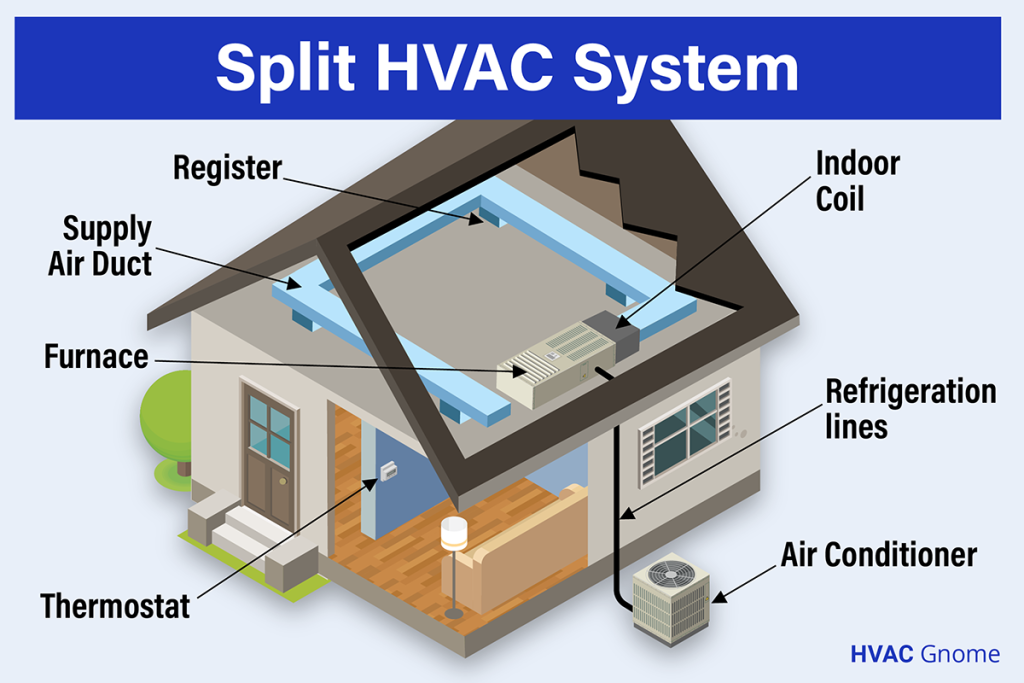
Guest posting
Guest posting is a content marketing and HVAC SEO strategy where you write and publish articles on other websites or blogs within the industry. In return, you usually get a backlink to your website.
This works well because:
- Both parties benefit: you get a backlink, while they get quality content.
- It allows you to target which websites you build links with.
- You can build authority by publishing valuable, relevant content.
- It exposes your brand to new audiences.
Here’s an example on the website for Indian heavy industry recruiters Venwiz. Indian HVAC engineers, KNND Associates PVT. Ltd., have written an article to help industrial plant owners decide how to choose an HVAC system.
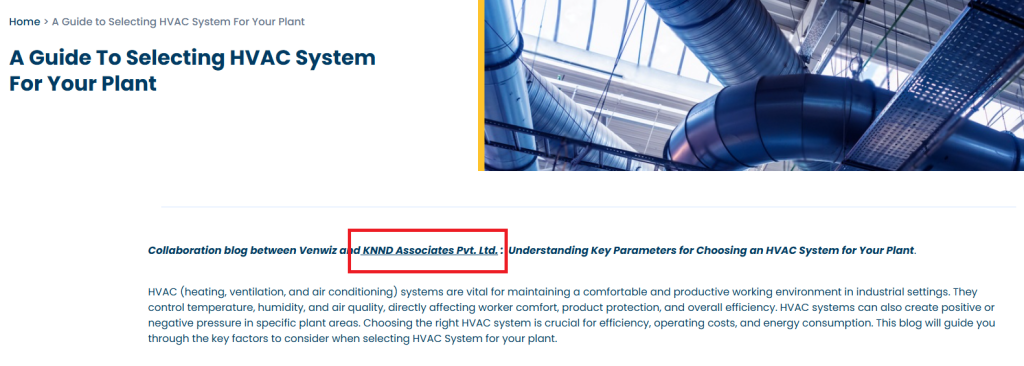
This works because:
✔️ It’s relevant: Venwiz’s industrial customers are likely in need of HVAC systems.
✔️ It’s quality content: The content is well-written and comprehensive.
✔️ It’s higher authority: Both websites have low authority—Venwis’s is significantly higher than KNND’s, positively impacting the latter’s rankings.
Let’s look at how you can find similar opportunities.
Finding guest posting opportunities with Google
The easiest way to find guest posting opportunities is to use Google search operators.
Many businesses that publish guest posts will have a page titled “write for us” or similar. You can use specialized Google searches to find these, including:
🔍 HVAC “write for us”
🔍 HVAC “guest post”
🔍 HVAC “contribute”
You should get a tonne of relevant results.

In addition, consider link insertion outreach to earn links: find existing HVAC-related articles where your website could be cited, and reach out to request a backlink placement.
7. Improve your technical SEO
Technical SEO are the “behind the scenes” parts of your website. They impact the user experience of your website.
Many technical SEO factors are difficult to understand and improve. However, two critical ones are worth addressing: mobile friendliness and Page Speed.
Mobile-friendliness
These days, around 80% of all searches take place on mobile devices. Your website should be optimized to provide a good experience for these users. Google prioritizes mobile-optimized sites.
Most hosting platforms offer responsive designs for consistent display across devices, optimize images for fast loading, and ensure text readability and button accessibility.
Google Search Console can be used to identify areas to enhance. This supports a better user experience and potentially boosts rankings.

Page speed
According to Forbes, users will wait an average of eight seconds for a page to load. After this, they will click away. Google therefore considers page loading speed as a ranking factor, ensuring it shows pages with a good experience to users.
You can test your site’s page speed using Google PageSpeed Insights. This will also list specific improvements you can make.

Outsource to an HVAC SEO agency
HVAC SEO can be time-consuming and difficult. It requires:
- Specialized knowledge
- Regular updates
- In-depth industry insights
Few HVAC companies have this in-house. It’s therefore worth outsourcing to an HVAC SEO company.
Additionally, agencies can access advanced tools and data analytics, making it more likely you will rank for high-intent, local keywords and attract quality leads.
This leaves you to focus on delivering services while benefiting from improved search visibility and increased conversions.
Authority Builders: HVAC SEO Experts
If you want to generate more business through your website, but don’t have time to dedicate to HVAC SEO, then speak to Authority Builders.
We provide HVAC SEO services like:
✔️ SEO strategy
✔️ Content creation
✔️ Link building
✔️ Digital PR
We’ve been helping businesses generate more search traffic since 2016. Check out our case studies to see the results we’ve achieved for our clients.
Book a call to find out how we can do the same for you.


